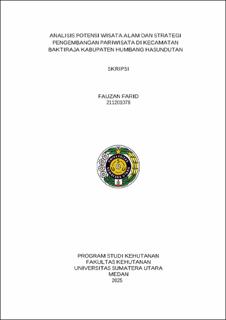| dc.description.abstract | This research is motivated by the rich natural tourism potential of Baktiraja Subdistrict, Humbang Hasundutan Regency, North Sumatra. The study aims to map natural attractions, assess their feasibility, and formulate strategies for sustainable tourism development. A descriptive quantitative approach was employed, combining spatial and descriptive analysis. The 2003 Guidelines for the Analysis of Operational Areas of Natural Tourism Objects and Attractions issued by the Directorate General of Forest Protection and Nature Conservation (PHKA) served as a reference for evaluation, while SWOT analysis was applied to design strategies. Findings reveal seven major natural attractions with high feasibility levels Goting Peak, Sibara-Bara Terraces, Janji Waterfall, Sigota-Gota Sipultak Hoda Waterfall, Aek Sipangolu, Topi Ni Tao Toba by CHADS, and Aek Sitio-Tio. Janji Waterfall recorded the highest feasibility score (83.12%), indicating strong potential for tourism development. Challenges identified include a shortage of skilled human resources and limited promotion, both of which hinder optimal tourism growth. To address these issues, the recommended strategy is SO (Strengths–Opportunities), which emphasizes leveraging natural potential while fostering community participation. This approach seeks to maximize existing strengths and opportunities, enhance local involvement, and promote environmental conservation. With proper implementation, natural tourism in Baktiraja Subdistrict is expected to develop sustainably, contribute significantly to the local economy, and preserve ecological balance. | en_US |


